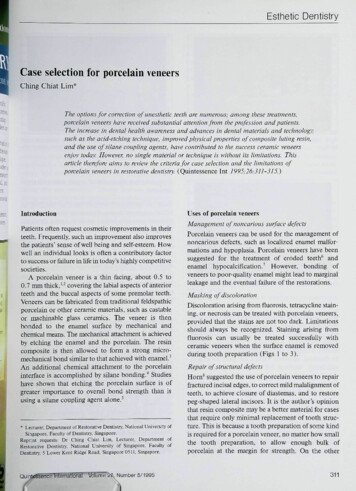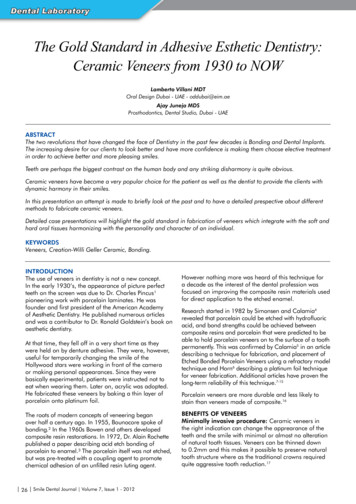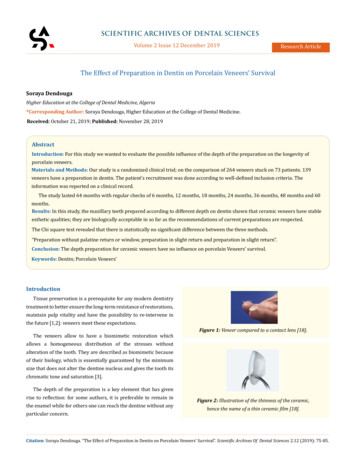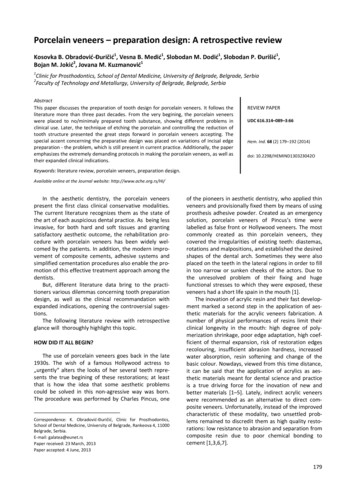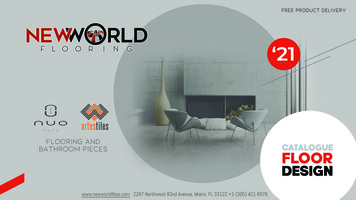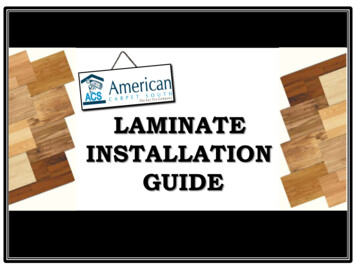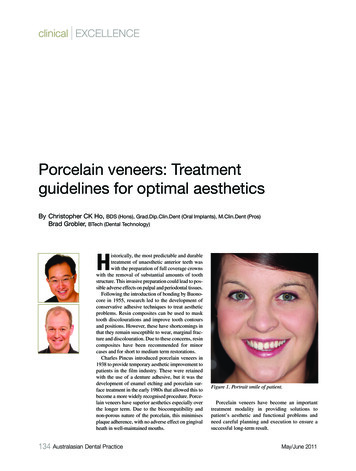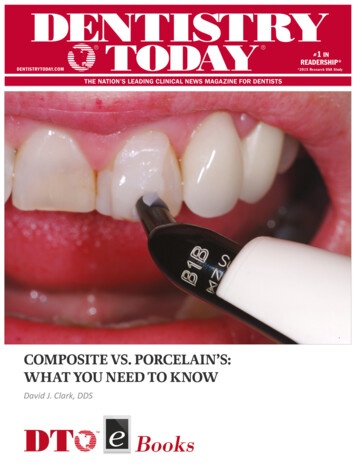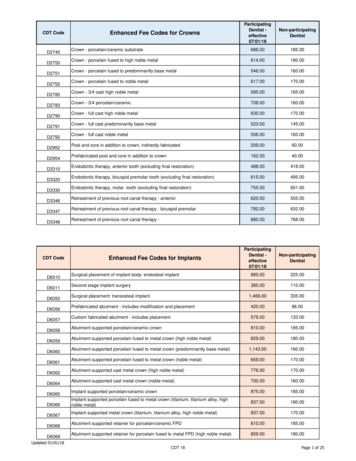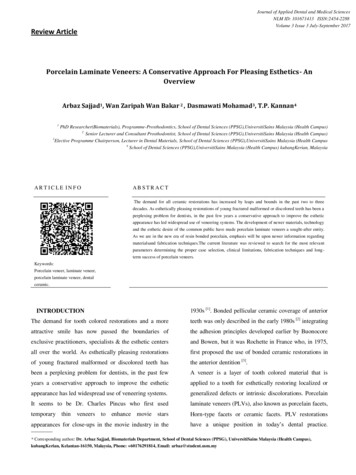
Transcription
Journal of Applied Dental and Medical SciencesNLM ID: 101671413 ISSN:2454-2288Volume 3 Issue 3 July-September 2017Review ArticlePorcelain Laminate Veneers: A Conservative Approach For Pleasing Esthetics- AnOverviewArbaz Sajjad1, Wan Zaripah Wan Bakar 2 , Dasmawati Mohamad3, T.P. Kannan41PhD Researcher(Biomaterials), Programme-Prosthodontics, School of Dental Sciences (PPSG),UniversitiSains Malaysia (Health Campus)2Senior Lecturer and Consultant Prosthodontist, School of Dental Sciences (PPSG),UniversitiSains Malaysia (Health Campus)3Elective Programme Chairperson, Lecturer in Dental Materials, School of Dental Sciences (PPSG),UniversitiSains Malaysia (Health Campus4School of Dental Sciences (PPSG),UniversitiSains Malaysia (Health Campus) kubangKerian, MalaysiaAR T IC LE IN FOAB STR ACTThe demand for all ceramic restorations has increased by leaps and bounds in the past two to threedecades. As esthetically pleasing restorations of young fractured malformed or discolored teeth has been aperplexing problem for dentists, in the past few years a conservative approach to improve the estheticappearance has led widespread use of veneering systems. The development of newer materials, technologyand the esthetic desire of the common public have made porcelain laminate veneers a sought-after entity.As we are in the new era of resin bonded porcelain, emphasis will be upon newer information regardingmaterialsand fabrication techniques.The current literature was reviewed to search for the most relevantparameters determining the proper case selection, clinical limitations, fabrication techniques and long term success of porcelain veneers.Keywords:Porcelain veneer, laminate veneer,porcelain laminate veneer, dentalceramic.INTRODUCTION1930s [1]. Bonded pellicular ceramic coverage of anteriorThe demand for tooth colored restorations and a moreteeth was only described in the early 1980s [2] integratingattractive smile has now passed the boundaries ofthe adhesion principles developed earlier by Buonocoreexclusive practitioners, specialists & the esthetic centersand Bowen, but it was Rochette in France who, in 1975,all over the world. As esthetically pleasing restorationsfirst proposed the use of bonded ceramic restorations inof young fractured malformed or discolored teeth hasthe anterior dentition [3].been a perplexing problem for dentists, in the past fewA veneer is a layer of tooth colored material that isyears a conservative approach to improve the estheticapplied to a tooth for esthetically restoring localized orappearance has led widespread use of veneering systems.generalized defects or intrinsic discolorations. PorcelainIt seems to be Dr. Charles Pincus who first usedlaminate veneers (PLVs), also known as porcelain facets,temporary thin veneers to enhance movie starsHorn‐type facets or ceramic facets. PLV restorationsappearances for close‐ups in the movie industry in thehave a unique position in today’s dental practice.* Corresponding author: Dr. Arbaz Sajjad, Biomaterials Department, School of Dental Sciences (PPSG), UniversitiSains Malaysia (Health Campus),kubangKerian, Kelantan-16150, Malaysia, Phone: 60176291814, Email: arbaz@student.usm.my
8PORCELAIN LAMINATE VENEERS- AN OVERVIEW 3(3);2017[3]Increased awareness of veneers and their potential hasinterferencesparked a lot of improvement regarding the technical andlaboratory on a 24‐ Karat gold matrix cast. A resin wasmaterial aspects.bonded to the saline‐ treated porcelain block & etchedDental laboratories have become proficient at makingenamel.both fired and pressed versions of ceramic veneers.developments in adhesive technology were carried outPerfect smiles improve the self‐confidence, personality,by Hornsocial life and have psychological effect on improvingGoldstien[11].h) 1985‐ Toulati et al., through their workself-image with enhanced self-esteem of the patient. Aswere responsible for the popularity of porcelainwe are in the new era of resin bonded porcelain,laminates in Europe[12].i) 1991‐ Feinman & Friedman [13]emphasis will be upon newer information regardingdid key work for augmenting restorative dentistry withmethods and techniques.PLVs.HISTORYMETHODSSurprisingly, the method of fabrication has not evolvedAn electronic search of publications was made using thetoo much since 1980, although the potential of bondedelectronic databases ScienceDirect and PubMed ceramics is well known, due to their ability to fulfill thethrough our institutional membership access. Thebiomimetic principle.inclusion criterion were abstract or full-text articles-Porcelain as a material for veneering was first reportedclinical trials, case reports, reviews or systematicby Horn and became popular in North America &reviews. The keywords were selected listing the[2]. The ceramic block was baked in theg)[2]1983‐InNorthAmerica,essential, Calamia[7-8], Christensen[9-10], Garber &Europe .following four combinations: (1) laminate veneer, (2)Then in, a)1930s‐ Dr Charles Pincus first used temporaryporcelain veneer, (3) porcelain laminate veneer (4) dentalthin veneers to improve the appearance of movie stars onceramic. Total of 147citations were identified and 29[1]close up .b)1955‐Bunocore‐introduced acid etchtechnique to increase adhesion of acrylic filling materialto[4]enamel .c)1958‐Bowenintroducedarticles meeting the inclusion criteria were included inthe review.Indications:BIS‐GMA[5].d)1970s - Faunce and Myers described theThree principal groups of indications are distinguished:bonding of prefabricated resin veneers, using adhesion of Tooth discoloration resistant to bleaching proceduresthe resin cement to enamel after etching .e)1970’s ‐(type I),“Mastique Veneer System” by Dentsply (preformed The need for major morphologic modification infactory processed plastic laminates). Relatively easy toanterior teeth (type II), andplace on the tooth- kit with a moderate selection of Extensive restoration of compromised anterior teethdifferent shapes and sizes that needed to be shaped to fit(type III).the selected teeth. They were technique sensitive, andType I: Teeth resistant to bleaching:there is high marginal discoloration. f)1975‐ Rochette inExamples of type I indications‐Include excessivelyFrance described a technique for making porcelaindiscolored teeth as a result of tetracycline stains (degreesrestorations for fractured incisors without operativeIII and IV according to Jordon & Boksman[14]; type I‐A[6]Journal Of Applied Dental and Medical Sciences 3(3);2017
9PORCELAIN LAMINATE VENEERS- AN OVERVIEW 3(3);2017and anterior teeth with severely attrited or eroded incisalneeded for the dental technician to fabricate an accurateedges that ultimately result in the exposure of theceramic piece[17-19].underlying dentin, type I‐B.b)a)black triangles:Type IA: Tetracycline discoloration:Type II B: Closure of diastemas and interdentalThe occurrence of type IA indications has been reducedInterdental black triangles are common sequelae ofrecently due to novel approaches in night guard vitalorthodontic alignment of crowded incisors or periodontalbleaching. These patients can even be treated bydisease. On the other hand, indirect porcelain laminatesbleaching beneath existing porcelain veneers. Type Ican overcome these problems, provided that specificsituations, are the most difficult to treat in terms of colortoothdepth as they require minimal tooth preparation. Thisembrasures present the same dilemma as diastemas, maymakes it a challenge for the ceramist to effectively maskalso be corrected with the rational, nonsurgical approachthe underlying discoloration as well as create the illusionusing interdental “mini‐wings” [16,17].of a PLVs within the contours of the adjacent naturalc)teeth[15].preparationis performed.OpenedcervicalType II C: Augmentation of incisal length andprominence:In teeth of older individuals, the incorporation of customTo increase the inciso-gingival height of incisors, directcharacterization such as deep coloration, craze lines andbonded composite resins can be placed, but it is now anspots can facilitate the blending of the veneers among theestablished fact that these resins succumb to early fatiguenatural adjacent teeth, in spite of the thinness of theresulting in chipping and wear if used to augment incisalceramic.edges [20,21].b)Type IB: Teeth unresponsive to external andConsequently, PLVs can be proposed to ensure a moreinternal bleaching:predictable result. A significant concern might be raisedThis category includes, for example, teeth with exposedthrough the marked anterior guidance that is createddentin and pulp less teeth. Veneered incisors demonstratewhen restoring incisal length and prominence. As therea stress distribution that cannot be differentiated fromseems to be an association between the absence ofthat within intact incisors under load. This is the essenceanterior guidance (i.e. open bite) and temporomandibularof biomimetics when restorations behave functionally asdisorders, “a key element in the development ofnatural teeth regarding strain and stress transfer, unlikeharmonious occlusion is therefore the incisal guidance,'teeth treated with extensive composite restorations1.[16].Type II: Major morphologic modifications:the steepness of which appears not to be important forneuromuscular harmony” [14,17,22].This group of indications consists of patients with very2.high expectations and there are three subcategories‐Extensive coronal fractures (type IIIA), extensive loss ofa)enamel (type IIIB) and malformations (type IIIC) areType IIA: Conoid teeth:Type III: Extensive restoration in the adult:Conoid teeth naturally present an ideal configuration forindications for this type of bonded porcelain restoration.the use of porcelain veneers. The required tootha)preparation is minimal; only a light marginal chamfer isPLVs act as a bandage and allow the vitality to beType III A: Extensive coronal fracture:maintained in teeth with considerable coronal fracture.Journal Of Applied Dental and Medical Sciences 3(3);2017
10PORCELAIN LAMINATE VENEERS- AN OVERVIEW 3(3);2017Wallet al., demonstrated that up to 2 mm of incisal edgecandidates for veneers. The shear stress generated is toospan of ceramics could be created on mandibular incisorsgreat for the porcelain to tolerate resulting in failure [25].without affecting the ultimate coronal strength [20].b)Type III B: Extensive loss of enamel:ADVANTAGESExtensive tooth abrasion is typically found in people of1.older age groups; of the maxillary teeth, the anteriormentioned here. First, is that porcelain offers betterteeth often exhibit the most wear. However, tooth surfaceshade control giving the sense of a natural look andloss is a growing problem in younger individuals [23].second it demonstrates long term stability of the chosenc)shade.Type IIIC: Generalized congenital and acquiredShade: There are two advantages to bemalformations:2.Examples‐ Generalized enamel dysplasia. It may bePLVs, the resin luting agent and the underlying preparedtreated successfully and conservatively with PLVs if theenamel is much stronger than any other veneeringdentino- enamel junction has not been altered[16].Bond strength: The bond between the etchedsystem.Generalized enamel dysplasia must be distinguished3.Abrasion resistance: Despite their fragility, oncefrom amelogenesis imperfecta. The latter requiresthe PLVs are luted into place and bonded to the enamelprudence: most frequently a full‐coverage prostheticthey demonstrate high shear and tensile strengths. This isprocedure remains the treatment of choice.evident by the fact that if for some reason PLVs need tobe removed, they cannot be dislodged from the teeth andCONTRAINDICATIONSneed be ground away using rotary diamond points.1.Insufficient enamel: There should be enamelPorcelain can therefore be used to increase the length ofaround the whole periphery of the laminate, not only forany given tooth by wrapping it over the incisal edge,adhesion but, more importantly, to seal the veneer to theboth because of its exceptional bond strength to enameltooth surface. In addition, there should be sufficientand because, the adhesive and cohesive strengths ofenamel available for bonding, because bonding to dentinporcelain are very high.is generally much less retentive than to enamel. If the4.tooth or teeth are composed predominantly of dentin andfluids to a lesser extent than any other commerciallycementum, crowing may well be the treatment of choiceavailable resin veneering systems.[24]5.Resistance to Absorption: Porcelain absorbsPeriodontal health: The highly glazed PLVsEnamel etch ability: It has been observed thatreduces the incidence of bacterial plaque accumulationdeciduous teeth and teeth that have been subjected towhen compared with direct bonded composite veneersexcessively fluoridation may be difficult to etch.thereby, preventing potential periodontal obeEsthetics: The esthetics achieved with PLVs issuccessfully bonded to PLVs.more superior to any other veneering material because of3.thehabitOral Habits: Patients with certain tooth to bitsasbruxism,may notJournal Of Applied Dental and Medical Sciences rpossibilities. Porcelain can be stained both externally andidealinternally and has a fluorescence similar to vital tooth.
11PORCELAIN LAMINATE VENEERS- AN OVERVIEW 3(3);2017Also, the PLV surface is more receptive to texturesilanization, they show extremely reliable bonding toalterations in order to mimic the surface texture of theresins."adjacent teeth.These advantages are also found in the platinum foiltechnique, which is the closest alternative to theDISADVANTAGESrefractory die technique but requires less effort in cast1.Time: The placement of PLVsis operator andmaking. In addition, data from the early 1990s,technique sensitive issue. Therefore, it requires carefulrepeatedly showed the superior marginal fidelity ofplanning and practice along with the know-how and idealplatinum foil veneersmanipulation of the luting agents. Thus, it can be safelyrelevance since the introduction of improved refractoryassumed that this procedure consumes substantial time.materials (eg. Ducera‐Lay, Ducera)and use of smaller2.individual dies[27].Repair: If during service the PLVs crack or[26]. These results have lost theirchip- off repairs are often difficult or impossible to2.execute.Castable Ceramic, Dentsply, York; PA)3.Castglass‐ceramicrestorations(DICOR Technique‐sensitive: The traditional process ofThey were first developed for all‐ceramic crowns. Thisfabricating veneers is an indirect one, requiring at leastmaterial demonstrates some unique physico- mechanicaltwo patient visits which involve impression making, andattributes. However, the high labor costs and limitedlaboratory costs.esthetics have prevented this system from further4.development.Color: It is not possible to modify the shade(IPSEmpress ,IPSe.max previously selected if the patient expresses the desire for3.the same once the PLVsare permanently luted into place.Press, Ivoclar Vivadent AG, Schaan; LI)5.Tooth preparation: Some tooth preparationThis type of reinforced pressable ceramic is either usedwithin the enamel may be required in order to preventto fabricate an entire restoration or only the core which ispotential problems that may arise from ensuingveneered later in a traditional manner. The latter optionover‐contouring of the PLVs.allows for esthetic characterization during additional6.ceramic layering. The room for esthetic improvements,Fragility: The veneers are relatively fragile andPressedceramicneed to be handled with great care.however,Choice of fabrication technique:full‐thickness layering that can be applied with the1.refractory die technique[28].Ceramic fired over refractory die: It is the oldest"isabitlimitedwhencomparedtoand most widespread method for fabricating a porcelain4. Slip cast ceramics (ln‐Ceram Spinell, ln‐Ceram piece. The main advantages of this technique are asAlumina, Vita Zahnfabrik, Bad Säckingen; Germany)follows: No special equipment is required. ExtremelySlip casting method of fabrication usually producessophisticated effects of color and translucency can berestorationsobtained through a full thickness layering technique. properties compared to other ceramic systems. ThisTraditional feldspathic porcelains can be used; whentechnology was originally intended for full coveragecombinedrestorations but was later adapted to PLVs sicmechanicalsubstituting alumina with spinel (MgAI2O6). However,Journal Of Applied Dental and Medical Sciences 3(3);2017
12PORCELAIN LAMINATE VENEERS- AN OVERVIEW 3(3);2017due to its high crystallinity and resulting enhancedCONCLUSIONmolecular density, traditional method of improvingThe demand for all ceramic restorations has increased bybonding by hydrofluoric acid etching became ineffective.leaps and bounds in the past twenty years. TheSimilarly, bonding of ln‐Ceram alumina to a resin lutingdevelopments of newer materials, technology and theagent, requires tribo-chemical silica coating or use of aesthetic desire of the common public have madespecial resin monomer5.[28]porcelain laminate veneers a sought-after entity. As the.demand and subsequent incorporation of PLVs in aMachinable ceramics:The combination of advancements in dental materials asrestorative treatment plan rises, the average dentalwell as in computer technology has made computer ‑operator finds him/herself weighing cautiously theassisteddesign/computer ‑ ailablematerial(CAD/CAM) fabricated PLV restorations possible inlimitations. Debonding, fracture and microleakage aredental clinics[29]. All CAD/CAM systems consist of threesome of the disheartening moments in an otherwisecomponents:popular & successful present which the PLVs have(1)A digitizationtool/scanner thattransforms the geometry into digital data that can beenjoyed.processed by the computer. (2) Software that processesThe overuse of PLVs should be avoided. Patientsdata and depending on the application, produces a datapresenting with multiple diastemas, severely overlappingset for the product to be fabricated. (3) A fabricationteeth, edge to edge occlusal relationship and bruxersscience that converts the data records into the physicalshould be considered for alternative treatment modalitiesrestoration. Since its introduction in the early 1980s, itratherhas evolved in three directions depending on the type ofporcelain laminate veneers.the production line, (a) chair-side production, e.g.However, it does not mean that these are absoluteCerec System (Sirona Dental GmbH; Salzburg,contraindications. With the understanding of tooth crownÖsterreich), (b) laboratory production, e.g., inEos X5biomechanics and the progress of dentin adhesives,scanner and inLab MC XL milling unit (Sirona Dentalbonded ceramic restorations present an extendedGmbH; Salzburg, Österreich), and (c) centralizedspectrum of indications for anterior teeth. To preventfabrication in a production center, e.g. Nobel Procera short‐term failures, the new generations of PLVs require(Nobel Biocare , Zürich Switzerland)[29].accurate knowledge of the stress distribution within theAll‐ceramic restorations designed and milled chair- side,tooth‐restoration complex. Aside from careful patienteliminate the need for traditional impressions andselection, by giving meticulous attention to veneertemporaries, and the patient leaves the appointment inpreparation, production and final luting, longevity of theabout an hour with a final restoration in place[30]. Thechances of success are, as high as traditionally fabricatedveneers; 98.8% of patients describe their CAD/CAMproduced solution as successful[31-32].Journal Of Applied Dental and Medical Sciences 3(3);2017thanindiscriminately restoring themrestoration can be improved.with
13PORCELAIN LAMINATE VENEERS- AN OVERVIEW 3(3);201713. Friedman MJ. Augmenting restorative dentistryREFERENCE1.2.3.4.Pincus CR. Building mouth personality. J Southwith porcelain veneers. J Am Dent Assoc 1991;Calif Dent Assoc 1938; 14:1 25‐ 129.122:29‐34.Horn HR. Porcelain laminate veneers bonded14. Jordon RE, Boksman l. Conservative vitaletched enamel. Dent Clin North Am 1983;bleaching treatment of discolored dentition.27:671‐84.CompendContinEduc Dent 1984; 5:803‐808.Rochette Al. A ceramic restoration bonded by15. Haywood VB, Porker MH. Night guard vitaletched enamel and resin for fractured incisors. Jbleaching beneath existing porcelain veneers: AProsthet Dent 1975; 33:287‐293.case report. Quintessence Int 1999; 30:743‐Buonocore MG. A simple method of increasing747.the adhesion of acrylic filling materials to5.6.enamel surfaces. J Dent Res 1955;34: 849‐53estheticBowen RL. Development of a silica‐resin directbiomimmetics. J Esthet Dent 1999; 11:5‐1 5.filling material. Report No.6333, Washington17. Urs C. Belser, Pascal Magne, Michel Magne .onDC: National Bureau of Standards.EsthetFaunce FR. And Myers DR. Laminate veneerLaminate Veneers: Continuous Evolution ofrestoration of permanent incisors. J Am DentIndications.Ceramic18. Magne P, Magne M, Belser U. Natural andAssoc 1976; 93: 790‐92.7.16. Magne P, Douglas WH. Rationalization ofCalamia JR. Etched porcelain veneers: Therestorative oral esthetics. Part II: Estheticcurrent state of the art. Quintessence Int 1985;treatment modalities. J Esthet Dent 1993;16:5‐ 12.5:239‐246.Calamia JR, Calamia CS. Dent Clin North Am.19. Magne P., Holz J. Restauration des dents2007 Apr;51(2):399‐417. Porcelain laminateantérieures. Principe, indications et limites desveneers: reasons for 25 years of success.techniques de traitement. Rev. Mens. SuisseChristensen GJ. Veneering of teeth: State of theOdontostomatol. 104:1247-1254, 1994art. Dent Clin North Am 1985; 29:373‐391.10. ChristensenGJ.JADA1999;130:1121.11. Garber AD, Goldstein RE, Feinman RA.laminateVeneers.Laminate veneers: A clinical study. J OralRehab 1988; 15: 439‐ 454.Ceramic veneers: state of the art 1999.Porcelain20. Walls AW, Murray JJ, McCabe JF. CompositeChicago:Quintessence, 1988.21. Tyes MJ. Correlation between properties andclinical performance of composite resins inClass IV cavities. Aust Dent J 1990; 35:46‐49.12. Toulati B, PlissorlVanockere. A Ceramic22. Magne P, Perroud R, Hodges JS, Belser U.bonded veneer. Toward a minimal prosthesis.Clinical performance of novel‐design porcelainReal Clin 1990; 1:51‐06.veneers for the recovery of coronal volume andlength. lnt J Periodontics Restorative Dent2000;20 :441‐457.Journal Of Applied Dental and Medical Sciences 3(3);2017
PORCELAIN LAMINATE VENEERS- AN OVERVIEW 3(3);20171423. Deery C, Wagner MI, Simon R, Nugent ZJ. The32. Wiedhahn K, Kerschbaum T, Fasbinder DF.prevalence of dental erosion in a United StatesClinical long-term results with 617 Cerecand a United Kingdom sample of adolescents.veneers: a nine-year report. Int J Comput Dent.Pediatric Dent 2000; 22:505‐5 10.2005; 8:233–246.24. Malone WF, Tylman SD, Koth DL. Tylman’sTheory and Practice of Fixed Prosthodontics.8th ed. St Louis: Ishiyaku Euro-America; 1989.25. Heyde JB, Cammarato VT Jr. A restorativesystem for the repair of defects in anterior teeth.The laminate veneers. Dent Clin North Am1981; 25:337-45.26. John A. Sorensen, Judith M. Strutz, Sean P.Avera and Daniel Materdomini. J Prosthet e of porcelain veneers made by twotechniques.27. Sheets CG, Taniguchi T. A multidie techniquefor the fabrication of porcelain laminatesveneers. J Prosthet Dent 1993; 70:291‐295.28. Kern M, Strub JR. Bonding to alumina ceramicin restorative dentistry: Clinical results over upto 5 years. J Dent 1998; 262: 45‐249.29. Santos GC Jr, Boksman LL, Santos MJ.CAD/CAM technology and esthetic dentistry: Acase report. CompendContinEduc Dent 2013;34:764, 766, 768.30. Seydler B, Schimitter M. Esthetic restoration ofmaxillary incisors using CAD/CAM chairsidetechnology – a case report. Quintessence Int.2011; 42:533–537.31. Wittneben JG, Wright RF, Weber HP, GallucciGO. A systematic review of the ns. Int J Prosthodont. 2009; 22:446–471.Journal Of Applied Dental and Medical Sciences 3(3);2017
first proposed the use of bonded ceramic restorations in the anterior dentition [3]. A veneer is a layer of tooth colored material that is applied to a tooth for esthetically restoring localized or generalized defects or intrinsic discolorations. Porcelain laminate veneers (PLVs), also known as porcelain facets,
